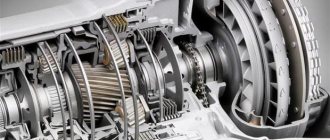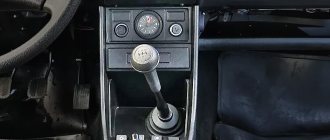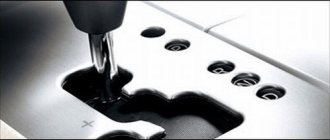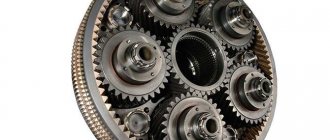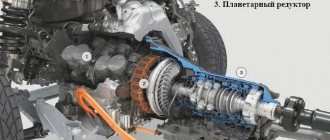In technical terms, an automatic transmission is much more complex than an engine. And repairing a machine requires more money than other components. In the event of a breakdown, you will have to pay several tens of thousands of rubles just for the parts. To this you will have to add the bill for diagnostics, disassembly, direct repair of the box, new oil and filter.
Correct use of automatic transmission operating modes will allow you to avoid repairs for a long time. It would seem that operating the machine is very easy. Select “Drive” and drive. After stopping, switch to position “P”, remove the key and get out of the car. Everything is simple, but there are some peculiarities.
What is automatic transmission and the history of its creation
Automatic transmission selector
An automatic transmission, or automatic transmission, is a transmission that allows the selection of the optimal gear ratio in accordance with driving conditions without driver intervention. This ensures a good smooth ride of the car, as well as driving comfort for the driver.
Currently, there are several types of automatic transmission:
- hydromechanical (classical);
- mechanical with two clutches (for example, DSG);
- robotic;
- continuously variable transmission (CVT).
In this article, all attention will be paid to the classic slot machine.
History of invention
The basis of the automatic transmission is a planetary gearbox and a torque converter, first invented exclusively for the needs of shipbuilding in 1902 by the German engineer Hermann Fittenger. Then, in 1904, the Startevent brothers from Boston presented their version of an automatic transmission, which had two gearboxes and resembled a slightly modified mechanics.
First production GM Hydramatic automatic transmission
A car equipped with a planetary gearbox first saw the light of day under the Ford T brand. The essence of the box was smooth gear shifting using two pedals. The first included upshifts and downshifts, and the second included reverse gears.
The baton was taken up by General Motors, which released a semi-automatic transmission in the mid-1930s. The clutch was still present in the car, and the planetary mechanism was controlled by hydraulics.
Around the same time, Chrysler refined the design of the gearbox with a fluid coupling, and instead of a two-stage gearbox, overdrive was used - an overdrive gear with a gear ratio of less than one.
The world's first fully automatic transmission was created in 1940 by the same company, General Motors. The automatic transmission was a combination of a fluid coupling with a four-speed planetary gearbox with automatic hydraulic control.
Today, six-, seven-, eight- and nine-speed automatic transmissions are already known, the manufacturers of which are both automakers (KIA, Hyundai, BMW, VAG) and specialized companies (ZF, Aisin, Jatco).
Pros and cons of automatic transmission
Like any transmission, automatic transmission has both pros and cons. Let's present them in the form of a table.
| Pros of automatic transmission | Disadvantages of automatic transmission |
| 1. Smooth and automatic gear shifting, creating comfort for the driver. | 1. Complexity of the design. |
| 2. No need to periodically replace the clutch. | 2. High cost of the box itself. |
| 3. Good dynamics due to the ability to manually change speeds. | 3. High cost of its maintenance. |
| 4. The automatic transmission can adapt to the driver’s driving style (adapt). | 4. Lower efficiency and increased fuel consumption compared to mechanics. |
Engine 2.5 and CVT
The variator imitates a 6-speed gearbox. These cars have a sport mode. This is necessary since the CVT is known for its smooth operation. Sport mode adds dynamics and sharpness to the car.
Engines 2.0 and 2.5 have an ECO indicator. The indicator lights up when driving economically. Usually on the highway, at a speed of 80-90 km per hour. Eco means eco-friendly mode. In a car, this is the same as economical. The computer reduces fuel injection into the combustion chambers, slightly reducing fuel consumption and carbon dioxide emissions.
Automatic transmission device
Automatic transmission diagram
The automatic transmission design is quite complex and consists of the following main elements:
- torque converter;
- planetary mechanism;
- automatic transmission control unit (TCU);
- friction clutches;
- overrunning clutch;
- hydraulic unit;
- band brake;
- oil pump;
- frame.
The torque converter is a housing filled with a special ATF working fluid and is designed to transmit torque from the engine to the gearbox. In fact, it replaces the clutch. It consists of pump, turbine and reactor wheels, a locking clutch and a freewheel.
The wheels are equipped with blades with channels for the passage of working fluid. A lock-up clutch is necessary to lock the torque converter in specific vehicle operating modes. A freewheel (overrunning clutch) is necessary to rotate the reactor wheel in the opposite direction. You can read more about the torque converter here.
The planetary mechanism of the automatic transmission includes planetary gears, shafts, drums with friction clutches, as well as an overrunning clutch and a band brake.
The gear shift mechanism in an automatic transmission is quite complex, and, in fact, the operation of the transmission consists of executing some algorithm for turning the clutches and brakes on and off using fluid pressure.
The planetary gear, or more precisely the locking of one of its elements (sun gear, satellites, ring gear, carrier), ensures the transmission of rotation and changes in torque. The elements included in the planetary gear set are locked using an overrunning clutch, a band brake and friction clutches.
An example of an automatic transmission hydraulic diagram
The automatic transmission control unit can be hydraulic (no longer used) and electronic (automatic transmission control unit). Modern hydromechanical transmission is equipped only with an electronic control unit. It processes sensor signals and generates control signals to the actuators (valves) of the valve body, which ensure the operation of friction clutches, as well as control the flow of working fluid. Depending on this, fluid under pressure is directed to one or another clutch, including a specific gear. The TCU also controls the torque converter lock-up. In the event of a malfunction, the TCU ensures that the gearbox operates in “emergency mode”. The automatic transmission selector is responsible for switching gearbox operating modes.
The following sensors are used in the automatic transmission:
- input speed sensor;
- output speed sensor;
- automatic transmission oil temperature sensor;
- selector lever position sensor;
- oil pressure sensor.
You can read more about automatic transmission sensors here.
Operating principle and service life of automatic transmission
The time required to change speed in an automatic transmission depends on the speed of the vehicle and the load on the engine. The control system calculates the required actions and transmits them in the form of hydraulic influences. Hydraulics move the clutches and brakes of the planetary mechanism, thereby automatically changing the gear ratio in accordance with the optimal engine mode under given conditions.
One of the main indicators affecting the efficiency of an automatic transmission is the oil level, which must be checked regularly. The operating temperature of the oil (ATF) is about 80 degrees. Therefore, in order to avoid damage to the plastic mechanisms of the box in winter, the car must be warmed up before driving. And in the hot season, on the contrary, cool it. The automatic transmission can be cooled by coolant or air (using an oil cooler).
Automatic transmission cross-section
The most common type is the liquid radiator. The atf temperature required for normal engine operation should not exceed 20% of the cooling system temperature. The coolant temperature should not exceed 80 degrees, due to this the atf is cooled. The heat exchanger is connected to the outer part of the oil pump housing, to which the filter is attached. As oil circulates in the filter, it comes into contact with the cooling liquid through the thin walls of the channels.
By the way, automatic transmission is considered very heavy. The weight of the automatic transmission is about 70 kg (if it is dry and without a torque converter) and about 110 kg (if it is filled).
For the automatic transmission to function properly, correct oil pressure is also necessary. The service life of the automatic transmission largely depends on this. The oil pressure should be between 2.5-4.5 bar.
The resource of an automatic transmission may vary. If in one car the transmission can last only 100 thousand km, then in another it can last about 500 thousand. This depends on the operation of the car, on regular monitoring of the oil level and its replacement along with the filter. It is also possible to extend the life of an automatic transmission by using original consumables and timely servicing of the transmission.
Automatic transmission control
The automatic transmission is controlled by the automatic transmission selector. The operating modes of the automatic transmission depend on moving the lever to a certain position. The following modes are available in the machine:
- R – Parking. Used when parking. In this mode, the transmission output shaft is mechanically blocked.
- R – Reverse. Used to engage reverse gear.
- N – Neutral. Neutral mode.
- D – Drive. Moving forward in automatic gear shift mode.
- M – Manual. Manual gear shift mode.
In modern automatic transmissions with a large number of operating ranges, additional operating modes can be used:
- (D), or O/D—overdrive—an “economical” driving mode in which automatic switching to an overdrive is possible;
- D3, or O/D OFF— stands for “disabling overdrive”, this is the active driving mode;
- S (or number 2 ) - range of low gears (first and second, or only second gear), “winter mode”;
- L (or number 1 ) - second range of low gears (first gear only).
Diagram of automatic transmission modes
There are also additional buttons that characterize the operating modes of the automatic transmission:
- Sport or Power button - gear changes occur at higher engine speeds;
- Winter or Snow button - moving from a standstill occurs from second or third gear;
- Shift lock button - the ability to unlock the selector when the engine is stopped.
Some boxes have a kick-down mode. The “kick down” mode involves sharp acceleration of the vehicle by switching to a lower gear. In some cases, kick-down mode is disabled when overdrive mode is turned off.
Engine 3.5 and 8 speed gearbox
The box also has S mode. In addition, the car can operate in three modes. Eco mode, normal, sport. You can switch the car to another mode by pressing a button. They are located at the gear selector.
When driving, the car feels sluggish and the response to the accelerator is slow. Fuel consumption becomes less. Well suited for a calm, leisurely ride. For example, for heavy traffic on a highway or city traffic jams.
The mode is well suited for single-lane highways when there is very little time to overtake. For mountain roads with constant climbs and turns.
All versions of the Toyota Camry received an automatic transmission with a sequential mode, which allows you to combine numerous functions of old automatic transmissions into one box. The flagship model received different engine operating modes, which will allow you to save fuel or make the most of the potential of the 3.5 liter engine.
Source
